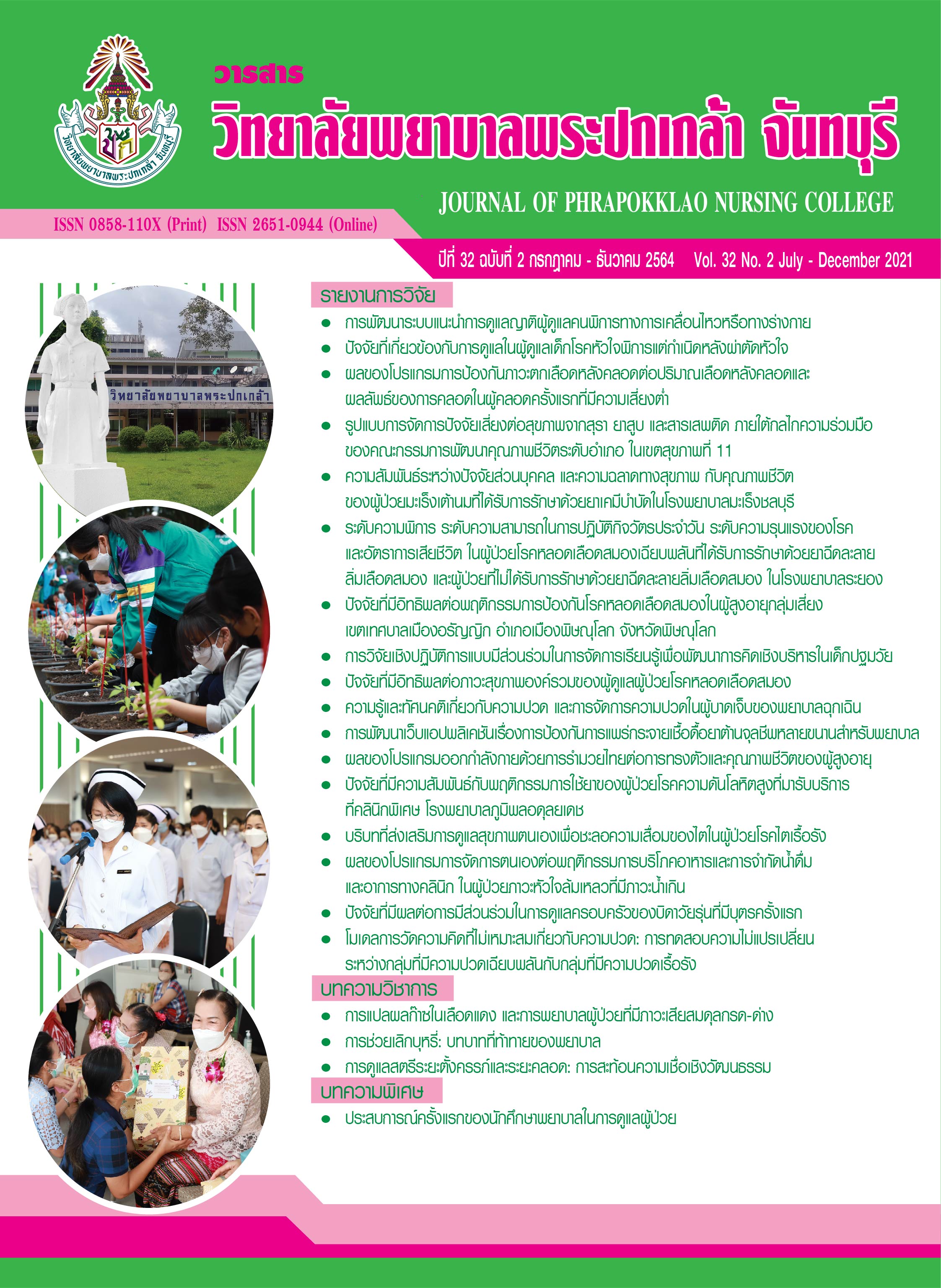Factors Influencing Preventive Behaviors for Cerebrovascular Disease among Elderly Risk Group in the Aranyik Town Municipality, Mueang Phitsanulok District, Phitsanulok Province
Keywords:
Preventive behaviors, Elderly risk group of cerebrovascular disease, Health belief modelAbstract
This predictive correlational research aimed to study preventive behaviors for cerebrovascular disease and influencing factors of preventive behaviors for cerebrovascular disease among elderly risk group. The samples were 313 elders with hypertension and/or diabetes mellitus who registered for treatment in the community health center and district health promoting hospital in the Aranyik Town Municipality, Mueang Phitsanulok District, Phitsanulok Province. The research instruments included the personal factors interview form, the knowledge about cerebrovascular disease interview form with reliability as .71, the personal perceived factors interview form with reliability as .74, the social support factors interview form with reliability as .93, and the preventive behaviors for cerebrovascular disease interview form with reliability as .73. Data were collected from March to May, 2019. Statistics used for data analysis included frequency, percentage, mean, standard deviation, and stepwise multiple regression analysis.
The research results revealed that the total mean score of preventive behaviors for cerebrovascular disease among elderly risk group was at a high level (M = 3.29, SD = .19). Social support from friend, perceived barriers of preventive behaviors for disease, social support from public health officer, social support from family, and being hypertensive and diabetic patient were statistically significant accounted for 11.20% of the variance of preventive behaviors for cerebrovascular disease among elderly risk group (R2 = .112, p < .05).
This research suggests that health care executives should encourage health care providers to promote the appropriate and accurate preventive behaviors for cerebrovascular disease among elderly risk group.
References
กลุ่มยุทธศาสตร์และแผนงาน สำนักโรคไม่ติดต่อ. (2559). รายงานประจำปี 2559. กรุงเทพฯ: สำนักงานกิจการโรงพิมพ์ องค์การสงเคราะห์ทหารผ่านศึกในพระบรมราชูปถัมภ์.
กองยุทธศาสตร์และแผนงาน สำนักงานปลัดกระทรวงสาธารณสุข. (2560). สถิติสาธารณสุข พ.ศ. 2559. สืบค้นจาก https://dohdatacenter.anamai.moph.go.th/coverpage/3a249d4706a9fec3b651595d3a507cd4.pdf
ขวัญฤทัย พันธุ, และจันทร์ฉาย มณีวงษ์. (2559). ปัจจัยทํานายพฤติกรรมส่งเสริมสุขภาพของผู้สูงอายุที่เป็นเบาหวานชนิดที่ 2 ในภาคกลาง. วารสารวิทยาลัยพยาบาลบรมราชชนนี นครราชสีมา, 22(1), 93–107.
ณัฐธยาน์ ภิรมย์สิทธิ์, จารีศรี กุลศิริปัญโญ, อรุณ นุรักษ์เข, และกิตติศักดิ์ หลวงพันเทา. (2561). ปัจจัยที่มีอิทธิพลต่อพฤติกรรมการป้องกันโรคในประชาชนกลุ่มเสี่ยงโรคหัวใจและหลอดเลือด จังหวัดสุพรรณบุรี. วารสาร มฉก.วิชาการ, 22(43–44), 55–69.
บุษราคัม อินเต็ง, และสุพัฒนา คำสอน. (2562). ปัจจัยที่มีผลต่อพฤติกรรมป้องกันโรคหลอดเลือดสมองในผู้ป่วยโรคความดันโลหิตสูง โรงพยาบาลส่งเสริมสุขภาพตำบลเมืองเก่า จังหวัดพิจิตร. วารสารวิชาการมหาวิทยาลัยอีสเทิร์นเอเชีย ฉบับวิทยาศาสตร์และเทคโนโลยี, 13(1), 122–134.
ปวิตรา จริยสกุลวงศ์. (2558). ปัจจัยที่มีอิทธิพลต่อพฤติกรรมส่งเสริมสุขภาพของผู้ป่วยโรคความดันโลหิตสูงวัยผู้ใหญ่ตอนต้น (วิทยานิพนธ์ปริญญามหาบัณฑิต). กรุงเทพฯ: มหาวิทยาลัยมหิดล.
พยาม การดี, พรรณพิมล สุขวงษ์, และดาว เวียงคำ. (2559). การรับรู้แรงสนับสนุนทางสังคมของผู้สูงอายุในเขตชนบทภาคเหนือตอนบน. วารสารสุขภาพจิตแห่งประเทศไทย, 24(1), 40–51.
พรรณิภา ภูกองพลอย. (2561). การพัฒนาวิธีการประมาณค่าข้อมูลสูญหายสำหรับการวัดซ้ำ (ปริญญานิพนธ์ปริญญาดุษฎีบัณฑิต). มหาวิทยาลัยมหาสารคาม.
ยุทธนา ชนะพันธ์, และดาริวรรณ เศรษฐีธรรม. (2561). ปัจจัยที่มีความสัมพันธ์กับพฤติกรรมการป้องกันโรคหลอดเลือดสมอง ในผู้ป่วยโรคความดันโลหิตสูง อำเภอกุมภวาปี จังหวัดอุดรธานี. วารสารโรงพยาบาลสกลนคร, 21(2), 109–119.
วาสนา เหมือนมี, สมลักษณ์ เทพสุริยานนท์, ชมนาด วรรณพรศิริ, และทวีศักดิ์ ศิริพรไพบูลย์. (2558). ปัจจัยที่มีอิทธิพลต่อพฤติกรรมการป้องกันโรคหลอดเลือดสมองในผู้ป่วยโรคความดันโลหิตสูง อำเภอบางระกำ จังหวัดพิษณุโลก. วารสารการพยาบาลและสุขภาพ, 9(2), 156–165.
ศูนย์เทคโนโลยีสารสนเทศและการสื่อสาร สำนักงานปลัดกระทรวงสาธารณสุข. (2560). อัตราป่วยด้วยโรคหลอดเลือดสมอง. สืบค้นจาก http://dmhc.dmh.go.th/hdc/reports/page.php?cat_id=6a1fdf282fd28180eed7d1cfe0155e11
สถาบันประสาทวิทยา. (2559). แนวทางการพยาบาลผู้ป่วยโรคหลอดเลือดสมองสำหรับพยาบาลทั่วไป. กรุงเทพฯ: ธนาเพรส.
สถาบันวิจัยและประเมินเทคโนโลยีทางการแพทย์. (2557). การทบทวนวรรณกรรม: สถานการณ์ปัจจุบันและรูปแบบการบริการด้านโรคไม่ติดต่อเรื้อรัง. กรุงเทพฯ: อาร์ต ควอลิไฟท์.
สมาคมความดันโลหิตสูงแห่งประเทศไทย. (2558). แนวทางการรักษาโรคความดันโลหิตสูงในเวชปฏิบัติทั่วไป พ.ศ. 2558. กรุงเทพฯ: ฮั่วน้ำพริ้นติ้ง.
สายฝน เติบสูงเนิน, และปิยธิดา คูหิรัญญรัตน์. (2560). ระดับการรับรู้อาการเตือนของโรคหลอดเลือดสมองในผู้ป่วยโรคความดันโลหิตสูง โรงพยาบาลส่งเสริมสุขภาพตำบลบ่อทอง อำเภอปากช่อง จังหวัดนครราชสีมา. ศรีนครินทร์เวชสาร, 32(5), 482–490.
สำนักงานสาธารณสุขจังหวัดพิษณุโลก. (2559). รายงานประจำปี 2559. สืบค้นจาก http://www.plkhealth.go.th/uploads/documents/รายงานประจำปี%202559.pdf
สำนักทะเบียนท้องถิ่น เทศบาลเมืองอรัญญิก อำเภอเมืองพิษณุโลก จังหวัดพิษณุโลก. (2559). กลุ่มโรคไม่ติดต่อ (NCDs). พิษณุโลก: ผู้แต่ง.
สุทัสสา ทิจะยัง. (2557). ปัจจัยที่มีอิทธิพลต่อพฤติกรรมการป้องกันโรคในผู้ป่วยกลุ่มเสี่ยงโรคหลอดเลือดสมอง (วิทยานิพนธ์ปริญญามหาบัณฑิต). นครปฐม: มหาวิทยาลัยคริสเตียน.
Daniel, W. W. (1995). Biostatistics: A foundation for analysis in the health sciences (6th ed.). New York: John Wiley & Sons.
Maiman, L. A., & Becker, M. H. (1974). The health belief model: Origins and correlates in psychological theory. Health Education Monographs, 2(4), 336–353. Retrieved from http://citeseerx.ist.psu.edu/viewdoc/download?doi=10.1.1.856.1372&rep=rep1&type=pdf
Ngamjarus, C., & Chongsuvivatwong, V. (2016). n4Studies: Sample size calculation for an epidemiological study on a smart device. Siriraj Medical Journal, 68(3), 160–170. Retrieved from https://he02.tci-thaijo.org/index.php/sirirajmedj/article/view/58342/48170
World Health Organization. (2017). Cerebrovascular diseases. Retrieved from http://www.who.int/topics/cerebrovascular_accident/en/
World Stroke Organization. (2017). Face the facts: Stroke is treatable. Retrieved from https://www.worldstrokecampaign.org/learn.html
Downloads
Published
How to Cite
Issue
Section
License
Copyright (c) 2021 JOURNAL OF PHRAPOKKLAO NURSING COLLEGE

This work is licensed under a Creative Commons Attribution-NonCommercial-NoDerivatives 4.0 International License.
เนื้อความ ข้อมูล และรายการอ้างอิงที่ผู้เขียนใช้ในการเขียนบทความเพื่อลงตีพิมพ์ในวารสารวิทยาลัยพยาบาลพระปกเกล้า จันทบุรี ถือเป็นความคิดเห็นและความรับผิดชอบของผู้เขียน คณะผู้จัดทำวารสารไม่จำเป็นต้องเห็นพ้องด้วยหรือร่วมรับผิดชอบ
บทความที่ได้รับการลงตีพิมพ์ในวารสารวิทยาลัยพยาบาลพระปกเกล้า จันทบุรี ถือเป็นลิขสิทธิ์ของวารสารวิทยาลัยพยาบาลพระปกเกล้า จันทบุรี หากหน่วยงานหรือบุคคลใดต้องการนำส่วนหนึ่งหรือทั้งหมดของบทความไปเผยแพร่ต่อเพื่อวัตถุประสงค์ใด ๆ จะต้องได้รับอนุญาตจากบรรณาธิการวารสารก่อน



